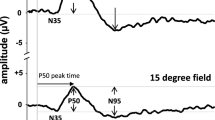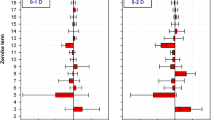Abstract
Conflicting results have been obtained concerning the parametric properties of the pattern electroretinogram. These discrepancies may be due to the large amount of variability inherent in recording amplitudes. We have found the variability within a single stimulus condition to be so large (ranging from 30% to 67% of the mean value) that it could mask any underlying spatial frequency tuning. Changing the stimulus conditions failed to significantly reduce the observed variability, although changing recording conditions produced some reduction. The use of a narrower rejection band, a greater number of sweeps, and placement of the reference electrode on the ipsilateral ear (as opposed to the ipsilateral temple) combined to decrease variability of the pattern electroretinogram within a single recording session; however, intersession variability remained high. Therefore one must be careful in evaluating data from this technique, and caution is advised in its clinical use.
Similar content being viewed by others
References
Maffei L, Fiorentini A. Electroretinographic responses to alternating gratings before and after section of the optic nerve. Science 1981; 211: 953.
Arden GB, Vaegan, Hogg CR. Clinical and experimental evidence that pattern electroretinogram (PERG) is generated in more proximal retinal layers than the foveal electroretinogram (FERG). Ann NY Acad Sci 1982; 388: 580.
Odom JV, Maida TM, Dawson WW. Pattern evoked retinal response (PERR) in human: Effects of spatial frequency, temporal frequency, luminance, and defocus. Curr Eye Res 1982; 2: 99.
Hess RF, Baker CL. Human pattern-evoked electroretinogram. J Neurophysiol 1984; 51: 939.
Arden GB, Vaegan. Electroretinograms evoked in man by local uniform or patterned stimulation. J Physiol 1983; 341: 84.
Sokol S, Jones K, Nadler D. Comparison of the spatial properties of the human retina and cortex as measured by simultaneously recorded pattern ERGs and VEPs. Vision Res 1983; 23: 723.
Armington JC, Brigell M. Effects of stimulus location and pattern upon the visually evoked cortical potential and the electroretinogram. Int J Neurosci 1981; 14: 169.
Reimslag FCC, Ringo JL, Spekrejise H, Verduyn LH. The distinction between luminance and spatial contrast components in the pattern ERG. Doc Ophthalmol Proc Series 1983; 37: 255.
Kirkham TH, Coupland SG. Pattern ERGs and check size: absence of spatial frequency tuning. Curr Eye Res 1982/83; 2: 511.
Berninger T, Schuurmans RP. Spatial tuning of the pattern ERG across temporal frequency. Doc Ophthalmol 1985; 61: 17.
Arden GB, Carter RM, Hogg C, Siegel IM, Margolis S. A gold foil Electrode: Extending the horizons for clinical electroretinography. Invest Ophthalomol Vis Sci 1979; 18: 421.
Schuurmans RP, Berninger T. Luminance and contrast responses recorded in man and cat. Doc Ophthalmol 1985; 59: 187.
Yanashima K, Yoshi M, Okisaka S. The relation between the after-negative potential of the pattern electroretinogram and the visually evoked cortical potential. Doc Ophthalmol 1986; 63: 137.
Korth M, Ilschner S. The spatial organization of retinal receptive fields in light and darkness as revealed by the pattern electroretinogram. Doc Ophthalmol 1986; 63: 143.
Sokal RR, Rohlf FJ. Biometry. (W.H. Freeman, 1969): San Francisco.
Odom JV, Norcia Am. Retinal and cortical potentials: spatial and temporal characteristics. Doc Ophthalmol Proc Series 1984; 40: 29.
Bodis-Wollner I, Bobak P, Harnois C, Mylin L. Methodological aspects of signal-to-noise evaluation of simultaneous pattern electroretinogram and visual evoked potential recordings. Doc Ophthalmol Proc Ser 1983; 40: 39.
Peachey NS, Seiple WH. Contrast sensitivity of the human pattern electroretinogram. Invest Ophthalmol Vis Sci 1987; 28: 151.
Adachi-Usami E, Kuroda N, Nakajima I. Distribution of pattern-evoked potentials in the facial area. Am J Ophthalmol 1983; 96:734.
Seiple W, Siegel I. Recording the pattern electroretinogram: a cautionary note. Invest Ophthalmol Vis Sci 1983; 24: 796.
Korth M, Rix R. Changes in spatial selectivity of pattern-ERG components with stimulus contrast. Graefe's Arch Clin Exp Ophthalmol 1985; 223: 23.
Hess RF, Baker CL, Verhoeve JN, Keesey UT, France TD. The pattern evoked electroretinogram: Its variability in normals and its relationship to amblyopia. Invest Ophthalmol Vis Sci 1985; 26: 1610.
Miller RF, Dowling JE. Intracellular responses of the Müller (Glial) Cells of the mud-puppy retina: their relation to b-wave of the electroretinogram. J Neurophysiol 1970; 33: 323–41.
Author information
Authors and Affiliations
Rights and permissions
About this article
Cite this article
Holopigian, K., Snow, J., Seiple, W. et al. Variability of the pattern electroretinogram. Doc Ophthalmol 70, 103–115 (1988). https://doi.org/10.1007/BF00154741
Issue Date:
DOI: https://doi.org/10.1007/BF00154741




